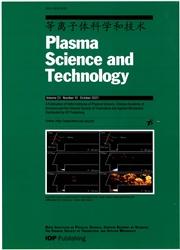A research on the effect of plasma spectrum collection device on LIBS spectral intensity
IF 1.6
3区 物理与天体物理
Q3 PHYSICS, FLUIDS & PLASMAS
引用次数: 0
Abstract
Only a small amount of spectral information is collected because the collection solid angle of the optical fiber probe and lens is very limited,when collecting spectral information. To overcome this limitation, this study presents a novel method for acquiring plasma spectral information from various spatial directions. A parabolic-shaped plasma spectral collection device(PSCD) is employed to effectively collect more spectral information into the spectrometer, thereby enhancing the overall spectral intensity. The research objects in this study were soil samples containing different concentrations of heavy metals Pb, Cr, and Cd. The results indicate that the PSCD significantly enhances the spectral signal, with an enhancement rate of up to 45%. Moreover, the signal-to-noise ratio also increases by as much as 36%. Simultaneously, when compared to the absence of a device, it is found that there is no significant variation in plasma temperature when the PSCD is utilized. This observation eliminates the impact of the spatial effect caused by the PSCD on the spectral intensity. Consequently, a concentration-spectral intensity relationship curve is established under the PSCD. The results revealed that the linear fitting R2 for Pb, Cr, and Cd increased by 0.011, 0.001, and 0.054, respectively. Additionally, the limit of detection (LOD) decreased by 0.361 ppm, 0.901 ppm, and 0.602 ppm, respectively. These findings indicate that the spectral enhancement rate elevates with the increase in heavy metal concentration. Hence, the PSCD can effectively enhance the spectral intensity and reduce the detection limit of heavy metals in soil.等离子体光谱收集装置对 LIBS 光谱强度影响的研究
在采集光谱信息时,由于光纤探头和透镜的采集固角非常有限,因此只能采集到少量的光谱信息。为了克服这一限制,本研究提出了一种从不同空间方向采集等离子体光谱信息的新方法。采用抛物线形的等离子体光谱收集装置(PSCD)可以有效地将更多的光谱信息收集到光谱仪中,从而提高整体光谱强度。本研究的研究对象是含有不同浓度重金属铅、铬和镉的土壤样本。结果表明,PSCD 能显著增强光谱信号,增强率高达 45%。此外,信噪比也提高了 36%。同时,与没有装置时相比,使用 PSCD 时等离子体温度没有明显变化。这一观察结果消除了 PSCD 空间效应对光谱强度的影响。因此,在 PSCD 下建立了浓度-光谱强度关系曲线。结果显示,铅、铬和镉的线性拟合 R2 分别增加了 0.011、0.001 和 0.054。此外,检测限(LOD)分别降低了 0.361 ppm、0.901 ppm 和 0.602 ppm。这些结果表明,光谱增强率会随着重金属浓度的增加而提高。因此,PSCD 能有效增强光谱强度,降低土壤中重金属的检测限。
本文章由计算机程序翻译,如有差异,请以英文原文为准。
求助全文
约1分钟内获得全文
求助全文
来源期刊

Plasma Science & Technology
物理-物理:流体与等离子体
CiteScore
3.10
自引率
11.80%
发文量
3773
审稿时长
3.8 months
期刊介绍:
PST assists in advancing plasma science and technology by reporting important, novel, helpful and thought-provoking progress in this strongly multidisciplinary and interdisciplinary field, in a timely manner.
A Publication of the Institute of Plasma Physics, Chinese Academy of Sciences and the Chinese Society of Theoretical and Applied Mechanics.
 求助内容:
求助内容: 应助结果提醒方式:
应助结果提醒方式:


